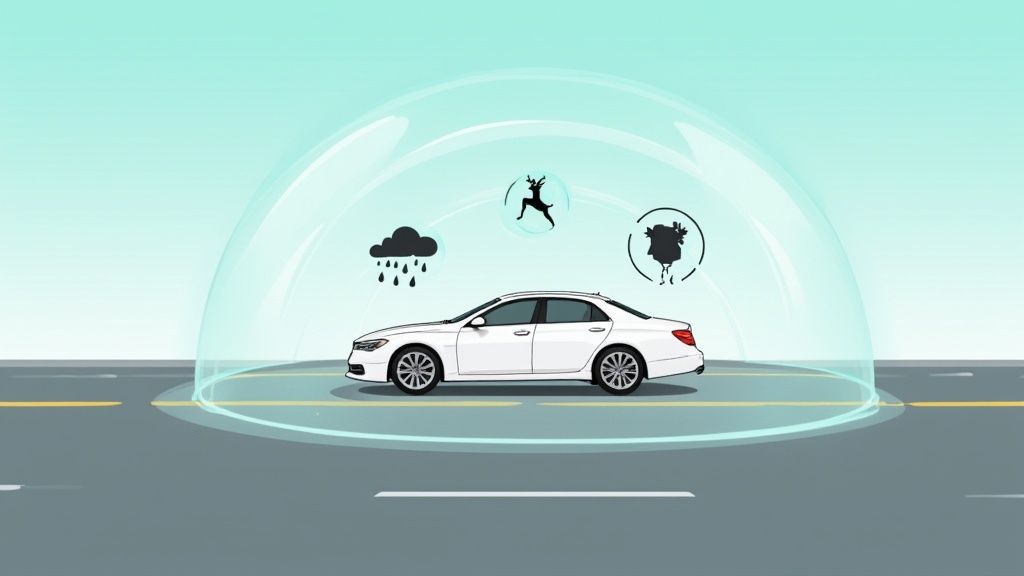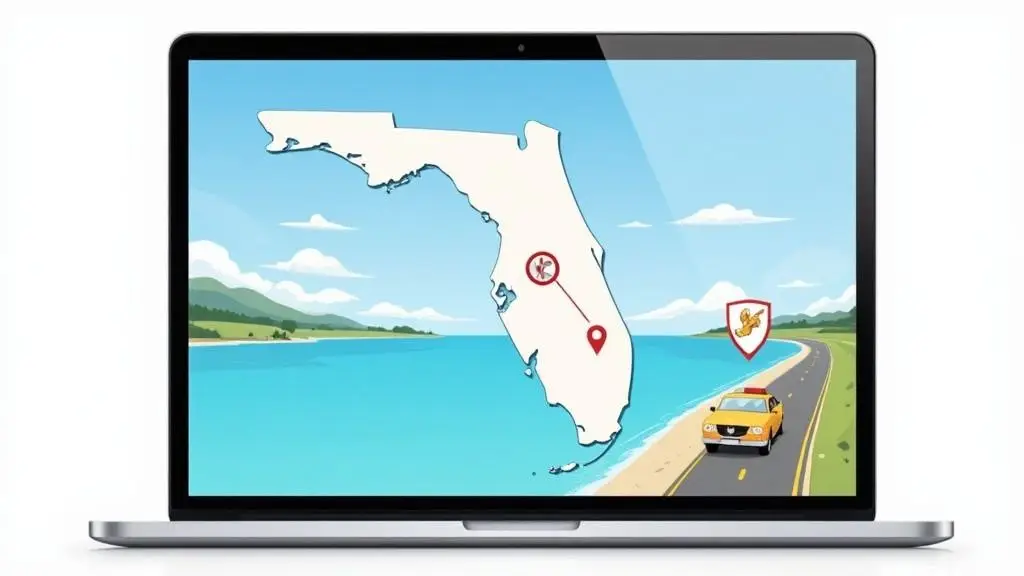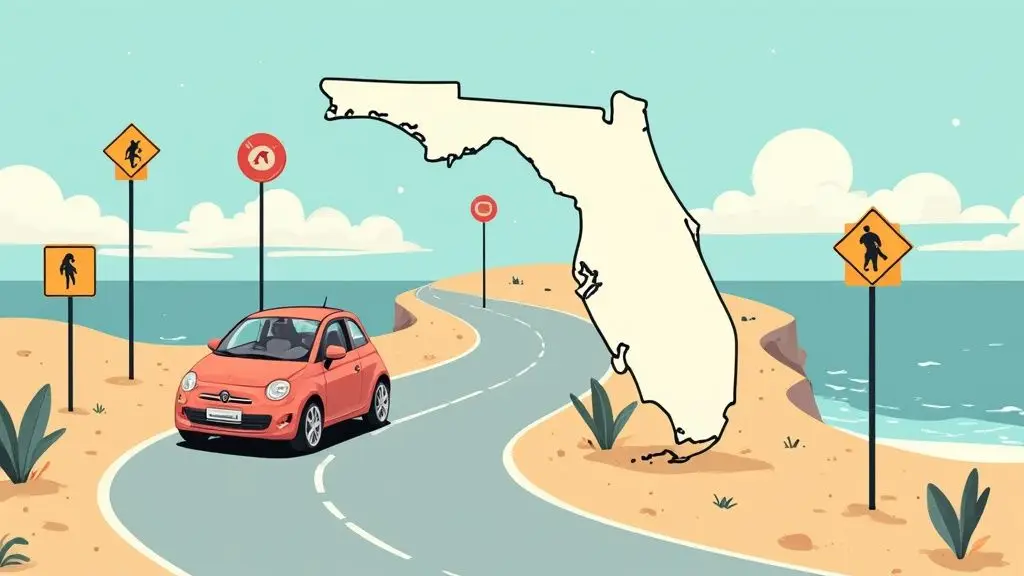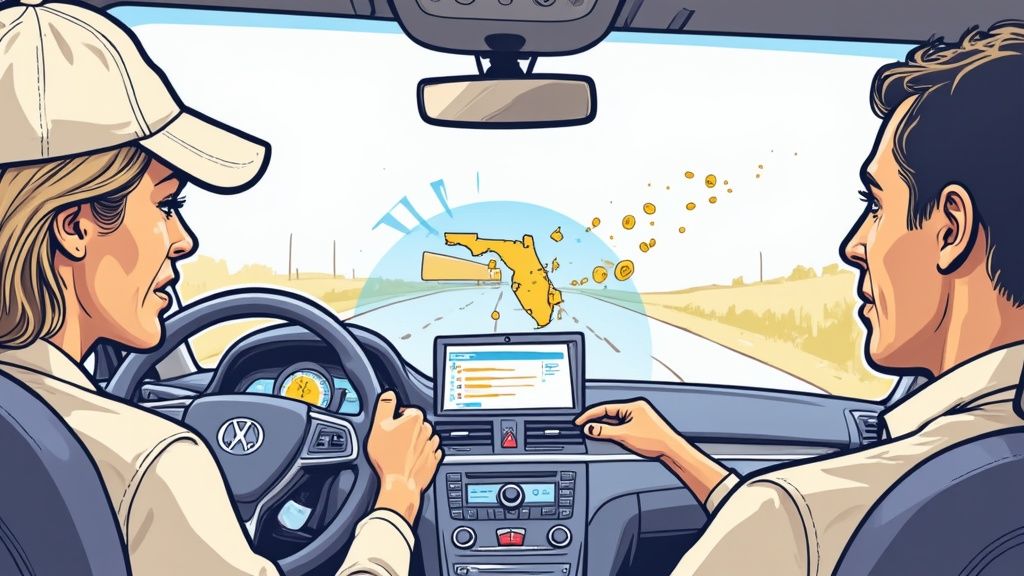Got a speeding ticket? Your first thought might be to just pay it and move on, but that’s often a costly mistake. The smartest move you can make is to opt for one of Florida’s speeding ticket classes, officially known as a Basic Driver Improvement (BDI) course.
Think of it as hitting a reset button after a minor traffic mistake. It’s a way to keep points off your license and, more importantly, stop your insurance company from jacking up your rates.
What Are Speeding Ticket Classes, Really?
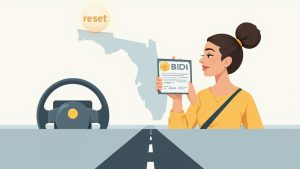
A Florida BDI course is much more than a boring lecture about stop signs. It’s a powerful tool for protecting your driving record. When you just pay a ticket, you’re pleading guilty, and the state automatically adds points to your license. That’s a red flag for your insurance company.
Choosing to take a BDI course is a proactive decision. This state-approved program acts like a shield. When you complete it, the court withholds adjudication, which is a fancy way of saying the points for that ticket never actually make it onto your permanent record.
The main goal here is to keep your record clean. Why? Because insurance companies base your rates on how risky you seem as a driver, and points scream “risk.” No points, no reason for them to raise your premiums.
Why a BDI Course Is Your Best Option
The choice to take a BDI course pays off immediately and down the road. It’s a small investment of time that prevents a whole cascade of financial headaches.
Let’s break down why this is such a no-brainer for most drivers.
Quick Look Why a BDI Course Is Your Best Option
| Benefit | How It Helps You |
|---|---|
| No Points on Your Record | The Florida DHSMV won’t add points for the violation, keeping your driving history clean. |
| Avoid Insurance Hikes | You sidestep the dreaded 25-40% premium increase that typically follows a speeding conviction. |
| Become a Safer Driver | The course is a great refresher on defensive driving, making you more aware and confident on the road. |
Basically, you’re turning a negative situation—getting a ticket—into a positive one. You’re not just following the rules; you’re taking control of the outcome.
It’s about empowerment. A BDI course gives you the power to manage the legal and financial fallout from a common driving mistake, rather than just accepting the consequences.
The Proactive Approach to a Traffic Ticket
Here’s a simple way to look at it: paying the fine is reactive. You’re accepting the points, the insurance hike, and everything that comes with it.
Taking a speeding ticket class is proactive. You’re actively deciding to protect your record, keep your insurance costs down, and maintain your peace of mind. It’s a single decision that can easily save you hundreds, if not thousands, of dollars over the next few years.
If you want to dig deeper into the specifics, you can learn more about what traffic school is and see how it works for drivers all over Florida. Honestly, it’s one of the best financial decisions you can make after seeing those flashing lights in your rearview mirror.
The True Cost of a Speeding Ticket
When that speeding ticket gets handed to you, your eyes probably go straight to the fine. It’s tempting to just pay it online and move on. But here’s something the fine doesn’t tell you: simply paying it is an admission of guilt. That one click starts a domino effect with consequences that will cost you way more than the initial penalty.
The real price tag isn’t that one-time payment. It’s the financial headache that can stick with you for years. Understanding these “hidden” costs is the key to making a much smarter choice—like taking a speeding ticket class.
The Florida Points System Explained
Florida, like most states, uses a point system to keep track of driving violations. Think of it like a demerit system in school. Each ticket adds points to your license, and if you get too many, you’re benched. When you pay a speeding ticket, you’re telling the state, “Yep, I did it,” and those points get locked onto your record.
For insurance companies, these points are giant red flags. Here’s a quick look at how they add up for speeding:
- Less than 15 mph over the limit: 3 points
- 15 mph or more over the limit: 4 points
- Speeding that results in a crash: 6 points
These numbers might not look like much, but their impact on your wallet is huge. Even a single ticket can be enough to bump you into a higher-risk category with your insurer.
The Financial Snowball Effect
Once those points land on your license, you can bet your insurance provider will raise your rates at your next renewal. And we’re not talking about a small bump. It’s common for drivers to see their premiums shoot up by 25% to 40% after just one speeding conviction. If your annual policy is $1,500, you’re suddenly looking at paying an extra $375 to $600 every single year.
The real cost of a speeding ticket isn’t the fine itself. It’s the compounding effect of higher insurance premiums over the next three to five years. A $200 ticket can easily snowball into a $2,000 problem.
This financial hit is a direct result of pleading guilty by paying the fine. The ticket is just the tip of the iceberg. To get a better sense of all the costs involved, take a look at our guide on how much a speeding ticket really costs.
The Risk of License Suspension
Points don’t just drain your bank account; they put your driving privileges at risk. The Florida Department of Highway Safety and Motor Vehicles (DHSMV) has strict limits, and they won’t hesitate to suspend your license if you cross them.
Here are the thresholds to watch out for:
- 12 points in 12 months = 30-day suspension
- 18 points in 18 months = 3-month suspension
- 24 points in 36 months = 1-year suspension
It’s surprisingly easy to hit these numbers. A couple of bad days on the road within a year could be all it takes to lose your license, causing chaos for your job, family, and daily life.
Let’s not forget the most important reason to slow down. The danger goes far beyond legal trouble. In 2023, speeding was a factor in 29% of all traffic fatalities in the U.S., according to the NHTSA. That stark number is a powerful reminder that safe driving is about protecting lives, not just avoiding fines. You can see the full report on speeding-related crash data from NHTSA.
When you add it all up—the fine, the years of inflated insurance rates, and the very real risk of losing your license—the true cost of a speeding ticket becomes clear. This is exactly why a BDI course is such a powerful option. It gives you a way to sidestep these consequences altogether.
Can You Take a Florida BDI Course?
So, you see the jaw-dropping costs of just paying that speeding ticket. The next logical question is, can you actually hit the reset button? The good news is that Florida’s Basic Driver Improvement (BDI) program is available to most drivers who’ve made a common mistake. But, as with anything involving the DMV, there are a few rules you need to follow.
Think of it like a simple checklist. The state has put some clear boundaries in place to make sure the program is used as intended—for correcting minor slip-ups, not as a get-out-of-jail-free card for repeat offenders. Understanding these rules is your first step toward confidently choosing a speeding ticket class.
This visual guide lays out the typical journey of a speeding ticket, from getting pulled over to the points and insurance hikes that a BDI course helps you sidestep.
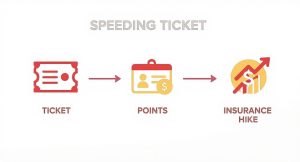
As you can see, choosing a BDI course is the critical fork in the road. It’s the decision that steers you away from the expensive consequences of points and higher insurance premiums.
The Two Golden Rules of BDI Eligibility
When it comes to qualifying for a BDI course in Florida, it really just boils down to two main time-based rules. These are designed to limit how often a driver can use this option to keep their record clean.
- The 12-Month Rule: You can only choose to take a BDI course once in any 12-month period. This is a rolling clock, not a calendar year. So, if you finished a course on August 15, 2023, you can’t take another one until after August 15, 2024.
- The Lifetime Limit: You can only use the BDI course option a total of five times in your entire lifetime. This is a hard limit, so it’s smart to save this benefit for tickets that actually carry points, not minor non-moving violations.
These two rules are the big ones. If you pass this test, you’re most likely good to go.
What Violations Qualify for a BDI Course?
Most everyday, non-criminal moving violations are eligible for a BDI course. The program was specifically created to address common driving errors and help you avoid points for those mistakes.
Eligible violations typically include things like:
- Speeding (as long as it’s less than 30 mph over the limit)
- Running a red light or stop sign
- Making an improper lane change
- Following too closely (tailgating)
If your recent ticket falls into one of these categories and you meet the time-based rules, you’re the perfect candidate for a speeding ticket class. If you’re curious about what you’ll learn, our Florida Basic Driver Improvement course gives a great overview of the topics covered.
When You Are Not Eligible for a BDI Course
It’s just as important to know what qualifies as what doesn’t. Florida law is very clear that BDI courses can’t be used for more serious offenses. These restrictions are there to ensure that major violations come with more significant penalties.
You cannot use a BDI course to dismiss points if you were ticketed for driving 30 mph or more over the posted speed limit. That kind of violation is considered too serious for a simple driver improvement course.
Other major reasons for disqualification include:
- Criminal Traffic Offenses: This covers serious violations like Driving Under the Influence (DUI), Reckless Driving, or leaving the scene of an accident.
- Commercial Driver’s License (CDL) Holders: If you were driving a commercial vehicle when you got the ticket, you are not eligible to take a BDI course to remove points from your record.
By checking your ticket against this list, you can figure out pretty quickly if a BDI course is the right move for you. For the vast majority of drivers with a standard speeding ticket, it’s easily the smartest and most affordable option on the table.
Choosing Between Online and In-Person Classes

So, you’ve decided a Basic Driver Improvement (BDI) course is the right move. Now you have another choice to make: should you go the old-school route and sit in a classroom, or take advantage of today’s technology with an online course?
It wasn’t long ago that your only option was a stuffy classroom with a fixed schedule. But now, online speeding ticket classes offer a much more convenient and, frankly, more effective way to get this done. One is built around your life, while the other forces you to build your life around it. For most Florida drivers, the choice is pretty clear.
The Old Way: A Classroom Commitment
Let’s talk about the traditional in-person BDI course. This is the one you see in movies: you drive to a specific location, find a seat in a room full of strangers, and spend a mandatory four-hour block listening to an instructor.
Some people might find comfort in that structured, face-to-face environment, but it’s packed with drawbacks.
- Inflexible Schedules: You have to clear your calendar and find a class that fits your schedule, which often means giving up a Saturday or taking a day off work.
- Extra Time and Costs: Don’t forget about the commute. You have to factor in driving time, gas money, and maybe even parking fees.
- One-Pace-Fits-All: The instructor has to teach to the middle of the room. That can feel painfully slow if you’re a quick learner or frustratingly fast if you need more time.
This model just doesn’t mesh with the way we live today. It’s a relic from a time before we had better options.
The Modern Solution: Online Flexibility and Control
Online BDI courses completely change the game. Instead of you working around the course’s schedule, the course works around yours. You can complete the material from anywhere you have an internet connection—your living room, a coffee shop, or even on your lunch break at work.
The freedom this gives you is the biggest advantage by far. You can log in and out whenever you want, breaking up the four hours of material into smaller, more manageable sessions. Do an hour in the morning, 30 minutes in the afternoon, and finish the rest tomorrow. It’s entirely up to you.
The real power of online traffic school is that it puts you in control. You decide the when, where, and how. It transforms a legal chore into a simple task that fits neatly into your life.
This flexibility is a lifesaver. No need to shuffle your work schedule, hire a babysitter, or waste an hour commuting. You learn at a pace that feels right for you, on your own terms.
Online vs Classroom Which Traffic School Fits You
Still on the fence? This side-by-side comparison should help you decide which BDI course format works best for your schedule and learning style.
| Feature | Online BDI Course | In-Person Classroom Course |
|---|---|---|
| Schedule | 24/7 access; start, stop, and resume anytime | Fixed class times, usually on weekends |
| Location | Anywhere with internet access | A specific physical address you must travel to |
| Pacing | Self-paced; review sections as needed | Instructor-led; moves at the group’s pace |
| Learning Style | Visual, interactive, independent learners | Auditory learners, group-focused, structured |
| Extra Costs | None; one-time course fee | Potential costs for gas, parking, and childcare |
| Convenience | High; fits into any schedule seamlessly | Low; requires you to block off a significant chunk of time |
Ultimately, the best choice depends on what you value most. If you need the structure of a classroom, in-person might work. But if you value your time and prefer a modern, flexible approach, online is the undeniable winner.
Keeping You Engaged in a Digital World
A common myth is that online courses are boring or less effective than having a live instructor. The truth is, a top-tier approved traffic school online uses dynamic content that is often far more engaging than a long lecture.
Modern courses are designed to hold your attention and help you actually remember the information using a variety of tools.
- Interactive Quizzes: Quick checks for understanding make sure you’ve grasped a concept before you move on.
- Engaging Videos: Videos can demonstrate complex driving situations much more clearly than a verbal explanation ever could.
- Animated Graphics: Visuals are perfect for breaking down traffic laws and defensive driving techniques into simple, memorable pieces.
This multimedia approach works for all kinds of learning styles, making it easier to retain what you’ve learned. Instead of just sitting and listening, you’re an active participant. You’ll not only pass the final exam but also walk away a smarter, safer driver.
Your Step-by-Step Enrollment Guide
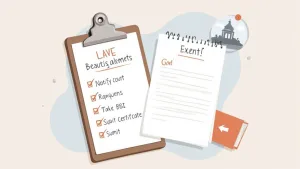
So, you’re ready to tackle that ticket and protect your driving record? Good call. Choosing to take one of Florida’s speeding ticket classes is a smart move, but you have to follow the process correctly. Think of this as your personal roadmap, guiding you from the moment you decide on the course to getting that certificate filed.
I’ll break it down into four simple steps. Following this guide will cut through the confusion and make sure you handle everything the right way, keeping those points off your license and your insurance premiums in check.
Step 1: Tell the Clerk of Court
This is your first, and most critical, move. Before you even think about signing up for a course, you have to formally notify the Clerk of Court in the county where you got the ticket. You must tell them you’re electing the traffic school option. This isn’t optional—it’s the law.
You typically have 30 days from the date on the citation to make this decision and pay the ticket fine. If you miss that deadline, you lose your chance to take the course altogether.
Here’s exactly what to do:
- Find the County: Look at your ticket—it will clearly state the county court.
- Contact the Clerk: Hop on the clerk’s website or give them a call to get their exact procedure for electing traffic school. Every county can be a little different.
- Pay Up and Elect: Follow their instructions to the letter. Pay the fine and officially state that you intend to complete a BDI course.
Step 2: Find and Enroll in a State-Approved Course
Once you’ve told the court, it’s time to pick a school. And here’s a crucial detail: you must choose a school approved by the Florida Department of Highway Safety and Motor Vehicles (DHSMV). If the school isn’t on their list, the court won’t accept your certificate.
Our BDISchool course is fully approved and accepted in all 67 Florida counties, so you can be confident your certificate will count. The enrollment process is quick, simple, and all online, letting you get started right away.
Step 3: Go Through the Course and Pass the Final Exam
After you enroll, you can jump right into the four-hour course. The best part about a quality online course is that you can do it on your own schedule. It’s designed to be convenient, breaking down Florida’s traffic laws and defensive driving skills into modules that are actually easy to follow.
You can log in and out whenever you want. Knock it out in one go or spread it over a few days—it’s entirely up to you.
The course generally covers practical topics like:
- Florida traffic laws you need to know
- Real-world defensive driving strategies
- Techniques for avoiding collisions
- Making sense of road signs and signals
At the very end, there’s a final exam. Don’t stress about it. The questions come directly from the material you just learned, and you get multiple chances to pass.
Step 4: Submit Your Completion Certificate to the Court
You’re almost there! This is the last and most important step. Once you pass your exam, your BDI provider will give you a certificate of completion. It is your responsibility to get this certificate to the Clerk of Court by the deadline they gave you.
Don’t make the mistake of assuming the school sends it for you. If you forget to submit that certificate on time, it’s the same as not taking the course at all. The points will go right onto your license.
Always double-check your deadline—it’s usually 60 to 90 days from the day you elected the school option. After you send it, it’s a good idea to call and confirm the clerk received it. Follow these steps, and you’ll put this ticket behind you and keep your driving record clean.
The Hidden Benefits of Traffic School
Let’s be honest, most people sign up for speeding ticket classes for one main reason: to keep points off their license. But what if I told you that was just the beginning? Think of traffic school less as a punishment and more as an unexpected opportunity.
It’s a chance to turn a frustrating situation—a speeding ticket—into a real win. You’re not just clearing your record; you’re also sharpening a skill you use every day, and that investment can pay off in ways you might not expect.
Unlocking Potential Insurance Discounts
Here’s the secret perk most drivers don’t know about: real savings on your car insurance. While taking a BDI course for a ticket is great for preventing your rates from increasing, voluntarily completing one can actually make them decrease.
Insurance companies see it as a simple numbers game. A driver who’s recently brushed up on defensive driving techniques is statistically a safer bet. They’re less likely to file a claim, which makes you a lower-risk customer. To reward you for being proactive, many insurers offer a nice discount, often in the range of 5% to 15% off your premium.
Over a few years, that discount can easily save you hundreds of dollars. The course essentially pays for itself, and then some.
Taking a BDI course isn’t just about damage control for a ticket. It’s a smart financial move that can lower your insurance costs for years, turning a one-time class into ongoing savings.
Becoming a More Confident and Aware Driver
Beyond the money, the real goal of a BDI course is to make you a better, more confident driver. These aren’t the stuffy, boring lectures you might be imagining. Modern speeding ticket classes are designed to give you practical, up-to-date skills for today’s roads.
You’ll walk away with new strategies for things like:
- Spotting Hazards Early: Learn how to read the road ahead and anticipate potential problems before they happen.
- Managing Modern Distractions: Get real-world tips for dealing with phones, GPS, and other things competing for your attention.
- Handling Tough Situations: Refresh your skills on what to do if you hit a slick patch or have to make a sudden emergency stop.
This knowledge is empowering. It helps replace that feeling of stress in heavy traffic or bad weather with a sense of control and awareness. Driving becomes less of a chore and more of a skill you can feel genuinely good about.
A Fresh Perspective on Driving Habits
It’s easy to fall into bad habits behind the wheel without even noticing. A good traffic school course acts as a reset button, making you consciously think about the little things you do every day, from following distance to checking blind spots.
This is especially critical if you drive a car that begs to be driven fast. For example, did you know the Subaru WRX is 49% more likely to get a speeding ticket than the average vehicle? A defensive driving course gives drivers of performance-oriented cars the mental tools to manage that temptation and stay safe. You can find more stats on vehicle models and speeding tickets that might surprise you.
At the end of the day, completing a course is a commitment—not just to the court, but to your own safety and the safety of everyone sharing the road with you.
Got Questions About Your Speeding Ticket Class? Let’s Clear Things Up.
Even when you know a BDI course is the smart choice, a few questions can still pop up. It’s completely normal. Let’s walk through some of the most common things Florida drivers wonder about when they’re going through this for the first time.
Getting these details sorted out will help you move forward with confidence.
How Much Time Do I Have to Finish the Course?
This is a big one. Your deadline isn’t set by us—it’s determined by the county court where you got the ticket. Once you tell the Clerk of Court you’re taking the course, they will give you a firm due date, which is usually between 60 and 90 days.
It is absolutely crucial to get this date directly from the clerk and mark it on your calendar. If you miss that deadline, the points go on your record automatically, even if you’ve already paid for and started the class.
Will My Insurance Company Find Out About My Ticket?
Nope, and that’s the whole point! When you complete a state-approved BDI course, the court officially “withholds adjudication.” In simple terms, this means they agree not to report the violation as points on your driving record.
Insurance companies pull your driving record to look for points when setting your rates. Since no points are added, they never see the ticket. This is exactly how you stop your premiums from skyrocketing.
A BDI course makes the ticket invisible to your insurance provider. The points never hit your record, so there’s nothing to trigger a rate increase.
I Got a Ticket in Georgia. Can I Use a Florida Course for It?
Unfortunately, a Florida-approved BDI course is only good for tickets you receive right here in Florida. Every state has its own traffic laws and its own system for driver improvement classes.
If you get a ticket while you’re out of state, you’ll have to play by their rules and follow the procedures for that specific jurisdiction. A Florida course just won’t count.
Ready to protect your driving record and keep your insurance rates from climbing? BDISchool offers a fully online, state-approved course that works around your schedule. Enroll today and take control of your ticket.
